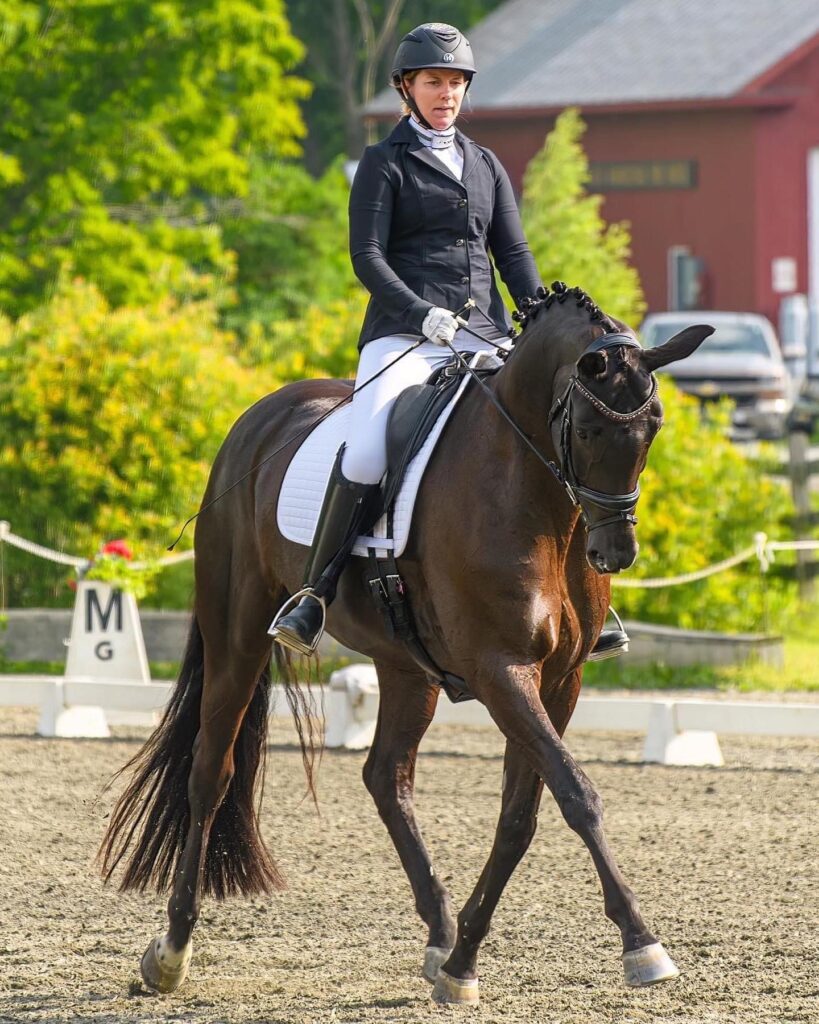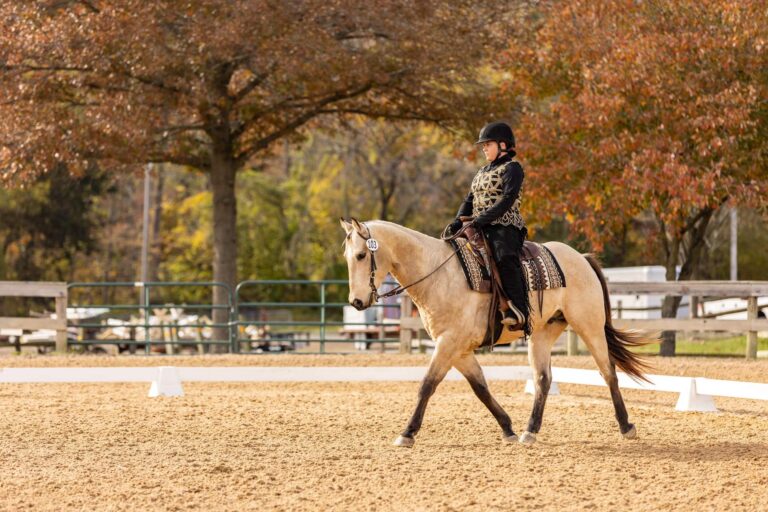This photo shows Larissa Williams on her Premium Oldenburg mare Sans Souci. Larissa purchased Sans Souci as a schoolmaster. She was trained up to Prix St. Georges and is now training Larissa through the levels. After two years, they are competing at Third Level, but in this picture, they are showing First Level, Test 3.

© Shawn Tinkman
There is a famous statement from the old German masters: Young horses need an experienced rider—and young riders need an experienced horse!
Being a “young” rider, Larissa did just the right thing when she got herself this schoolmaster mare. One can see in the picture already that this horse has been trained. She looks like an elegant dancer, light on her feet and nicely balanced. I love the expression of the horse with one ear forward to the task ahead and the other ear slightly to the side listening intently to her rider asking if she wanted anything different.
The angle the picture is taken is a bit tricky to judge, but I would guess it was taken during a leg-yield movement as the hind leg is tracking a bit to the left side, and the front leg is in the direction of crossing. The slight right flexion and the way Larissa is pushing with the leg at the side solidifies
this impression.
Ideally, Sans Souci should carry her neck and head a little more up to ensure that the poll is the highest point, but the overall impression of harmony between these two is more important than two centimeters of self-carriage.
Larissa is concentrating and riding with a nice, upright position. I like the natural way she carries her shoulders and hands, and her upper-body balance already looks advanced and stable. The weakest link in this picture is her right lower leg and stirrup position. Her lower leg is a bit turned out, and this can cause some unwanted tension in the hip.
Stirrup Position
Looking at the position of the stirrups, I can see that her right stirrup is tilting sideways where the left stirrup looks more parallel to the ground. Ideally, the stirrup bar (where we place the ball of the foot) should be parallel to the ground. Larissa wants to push her horse with the lower leg sideways, but she is locking her knee and hip. This causes her foot to push the stirrup to the side.
While watching some really good rides at the European Championship, I was amazed how during the lateral movements, the feet of the riders seemed to simply rest on the stirrup without any tilt or movement during a half-pass.
A supple leg that is grounded to the stirrup is an art! It needs positive tension and a lot of coordination and core stability. Have you ever climbed up a rope ladder? The moment one puts weight in the foot on the rope it swings off to the side.
The stirrup leather is attached up on the saddle very close to the rider’s hip joint. Stepping into the stirrup will trigger the whole stirrup leather and iron to start moving off to the side. In addition to coordination, controlling the stirrup position requires a lot of control of the rider to keep the leg stable and follow the horse’s movement.
The rider’s hips, knees and ankles absorb the energy as if the leg was an elastic rubber band, and the stirrup becomes the stability point. The more the stirrup moves, the less the hip will move. The correct use of the stirrup enhances the mobility of the hips and allows the rider to influence the horse’s movement with effective but invisible aids.
To learn to feel and control the stirrup, I often recommend the following exercises.
Exercises to Improve Stability
While sitting in walk on your horse, push gently with the ball of the foot onto the stirrup and feel that this connects the hip and the foot. Then try to move the whole leg in small circles. This should not be just the lower leg; it should move as if you wanted to move the leather of the stirrup. The movement starts from the hip joint and the point where the stirrup leather is attached to the saddle. Compare both sides. Often one leg can do this more easily than the other leg.
After the leg circles, keep the stirrup in the correct place and start slowly standing up. At first it may be easier to lean forward with the upper body and maybe even look down toward your feet. The stirrup should not move while standing up and when sitting down again. Once you have developed a feel for the stability of the foot, start your rising trot and check that you can maintain this. Then your leg can stay efficiently on the horse’s side while rising.
It becomes more challenging when you try to keep the upper body more upright in the dressage position. Later you can always test yourself if it is possible to balance a dressage position while standing in the stirrups for a couple of strides. This needs control of the legs. The legs need to stay on the horse without squeezing or having tension of the knees. In German, we call this a “closed seat” (geschlossener Sitz) meaning surrounding the horse with a breathing, elastic leg position.
The more stability and length created in the upper body, the easier it will be to keep the leg long and on the horse’s side. This may sound weird, but the muscles of the legs that run over the hip joints all reach into the upper body. They are attached to the pelvis, to the lower back and some even as high as the diaphragm. This explains how a correct shift of weight in the upper body will connect to the correct leg aid.
Once Larissa learns to master the stirrup control, her nice upper body stability will help her maintain her leg at the horse’s side while applying the forward–sideways aid inside the leg-yield.
A better connection of seat and legs stabilizes the horse’s balance, and less hand and rein control will be needed. This hopefully will result in better self-carriage, and then Sans Souci could keep the poll as the highest point with the same elegance and ease as she is moving her legs.
Larissa and Sans Souci are now already competing at Third Level. I am sure they have developed on their journey. A more precise stirrup control can refine Larissa’s aids to be able to learn from her wonderful schoolmaster and continue her dressage journey through the levels.
Best of luck and joy to them.
About Susanne von Dietze

Susanne von Dietze is a leader in equestrian biomechanics. A physiotherapist, licensed Trainer A instructor and judge for dressage and show jumping, she gives lectures and seminars throughout the world, including at the prestigious German Riding Academy in Warendorf. She is a native of Germany and now lives with her husband and three children in Israel, where she competes at the international level. She is the author of two books on the biomechanics of riding: Balance in Movement and Rider and Horse, Back to Back.











